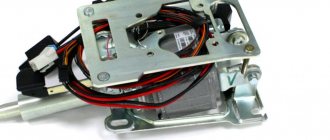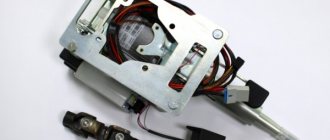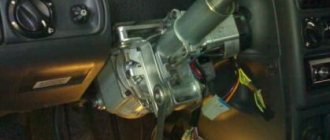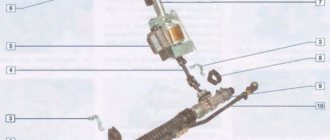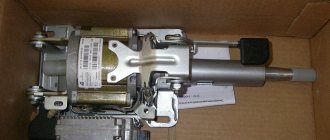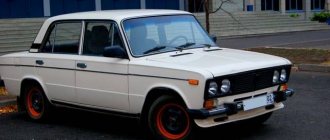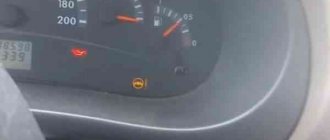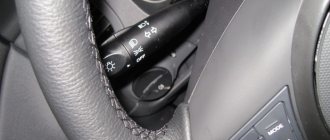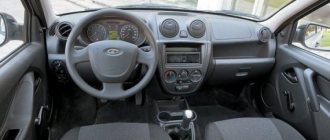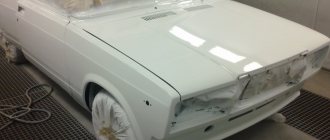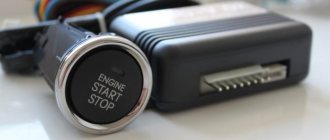VAZ 2110 cars are equipped with electric power steering, which makes drivers incredibly happy. This addition significantly improves the maneuverability and controllability of the car, which allows the driver to feel more confident on the road.
In addition, the driver does not need to exert much effort to control the steering wheel, which makes it possible to make long trips without feeling tired.
Electric power steering for VAZ 2110 cars can be installed independently if necessary, but to do this you need to understand the device.
Story
Back in 2002, engineers from the Novosibirsk Technical University developed this electric power steering, which has become so popular. After all stages of creating the device were completed, the device was tested at the VAZ plant for several years.
Russian manufacturers have done everything to ensure reliable and high-quality advantages of the unit over similar foreign-made devices. The amplifier uses alternating current, which ensures reliable and durable operation.
Priora electric power steering diagram
But the main thing for our drivers was the acceptable cost of this unit, much lower than that of Western components. In addition, the electric booster can become a reliable protector against theft. Since electric amplifiers were invented for domestic brands, they are produced accordingly in Russia, at the Berdsk Electromechanical Plant, which became a subsidiary of VAZ.
The electric power steering itself was first invented and implemented back in 1990 in Japan at the factories of the Toyota concern. The first advantages of the device that it showed were characterized by the following indicators:
- The unit operates even when the engine is turned off;
- When the component operates, significant fuel savings may be observed over a period of time;
- All controllability indicators are significantly improved;
- Control reliability reaches great heights;
- Creates good safety conditions for constant driving.
Differences from power steering
You need to understand that power steering is a power steering and these two devices are constantly compared, figuring out which one is better. In general terms, we can say that these two components may have common characteristics, but the electric amplifier contains an electronic unit.
It is this difference that makes it more functional, and its performance is characterized by the following indicators:
- The sensors of the electronic unit constantly monitor the speed of movement, they read its trajectory and monitor the serviceability of the working components;
- After the data is collected, it is transferred to a special electronic control unit where it is processed;
- The artificial intelligence of the control system changes the parameters of the master cylinder automatically;
- The oil pressure level is adjusted only by the position of the valve; it can be either open or closed;
- The higher the speed the car begins to pick up, the more intensively and actively the valve opens;
- In the process of increasing speed, the severity of steering wheel control also increases in parallel, and this in turn increases the degree of safety and stability when driving the VAZ 2110;
- In addition, the operation of the electric booster is not affected by the presence of fuel, it does not affect its consumption.
If the effectiveness of the braking system decreases sharply, then there is a high probability that the problem is related to the master cylinder. This article will help you replace it:
Design and principle of operation of electric power steering
The main elements of the system are a brushless electric motor, a mechanical transmission (servo drive), steering angle and torque sensors and a control unit. Additionally, the mechanism can be equipped with a steering speed sensor. The servo drive design varies across different vehicle types (more on this below).
The main sensor in the electric power steering is the torque sensor. It is made as follows: a torsion bar is built into the section of the steering shaft, at the ends of which sensor elements are installed, the operating principle of which can be optical or magnetic.
The operating principle of electric power steering is as follows. When the steering wheel is turned, the torsion bar on the shaft is twisted the more strongly, the greater the force applied. The magnitude of the applied force is estimated by the relative position of the sensor parts. The measured value is transmitted to the control unit. The second sensor measures the steering angle and also transmits measurements to the control unit, which additionally receives data on the vehicle speed (from the ABS system) and engine speed (from the controller). And based on all the information received, the electronic control unit calculates the amount of auxiliary force and supplies the electric motor with a voltage of the required value and polarity. Through a servo drive, the electric motor moves the steering rack or rotates the steering shaft.
When driving at low speeds, for example in a parking lot, when you have to quickly turn the wheels from one extreme position to another, the electric motor operates with maximum power, and the so-called “light steering” is provided. And vice versa, when the car is driving along the highway at high speed, the steering wheel turns at small angles, so the auxiliary force is minimal, the steering wheel turns out to be “heavier”. In addition, electric power steering can increase the reaction force that occurs when turning the wheels, helping them return to their center position.
Often there is a need to maintain the average position of the wheels, for example, in the event of strong gusts of side wind or uneven tire pressure, in such situations the control unit provides a constant corrective force. The system software also includes compensation for the sideways movement of a front-wheel drive vehicle due to different lengths of the wheel drive shafts.
Principle of operation
The work of EMURU, that is, the electromechanical power steering, is aimed at reducing the driver’s control efforts. The device is also designed to actively return the steered wheels and steering wheel to their original position after a maneuver. Fewer turns of the steering wheel will return the wheels to their original position.
Thanks to the device, the car returns to straight-line motion faster, which ensures driving safety.
The unit itself is a modular design that is built into the steering column.
The module consists of two main components:
- The power unit is a synchronous electric device;
- Control type controller.
The installation of an electric booster is especially important if the owner of a VAZ 2110 installs wider tires on large-diameter wheels compared to standard factory ones. Such a problem as an “unruly” steering wheel is eliminated in the case of electric power assistance; the steering wheel obeys the driver even with a light touch.
General diagram of electric power steering
If previously the driver had to constantly hold the steering wheel with both hands and put a lot of effort into turning it, now everything can be done with one finger.
Thanks to these indicators, the VAZ 2110 is considered one of the safest cars on domestic roads.
One of the main components of the brake system is the caliper. Details of self-repair of this part are outlined here:
The need for power steering
VAZ 2112 cars coming off the factory assembly line do not contain power steering. This fact may indicate that the machine simply does not need such a device. However, you can find power steering on sale and install it yourself. Before buying anything, spending time and effort, it would be wise to weigh all the facts.
Arguments in favor of hydraulic booster
Aspects that indicate the need to install this device are as follows:
- Facilitation of parking;
- Reduced effort on long turns;
- Increased ease of control on the road.
As you can see from the list, there are few arguments. But for some drivers they are very important.
Ease of parking
The main purpose of the VAZ 2112 power steering is to reduce the effort when turning the wheels. In winter, when the surface is slippery, turning the wheel of a stationary car is quite simple. But if you imagine that there is asphalt under the car with small stones sticking out and digging into the tire, then you will have to make a lot of effort to perform the desired maneuver.
At such moments, it is best to start turning the wheels immediately after starting to move, as this helps reduce the load on the steering mechanism. If the parking process causes a lot of inconvenience to the driver, then you should think about installing power steering. This is often typical for female drivers.
Reduced effort in movement
Moving along a straight path and a flat surface, driving the VAZ 2112 does not cause much trouble. But when entering a sharp turn, changing the trajectory of the car requires effort.
This is due to the fact that it is affected by centripetal acceleration, the vector of which is directed perpendicular to the car. At such moments, power steering will be very useful.
Arguments against the amplifier
After analyzing the positive factors, the driver will immediately want to install an amplifier for himself. But besides the positive, there are also negative aspects. These include:
- Repair costs;
- Labor intensive installation process;
- Changes in body design.
The power steering mechanism of the VAZ 2112 has significant shortcomings. The degree of their significance for the driver determines the further decision. The existing aspects should be assessed as objectively as possible.
Repair costs
Over time, any mechanism wears out and needs repair. It is clear that an increase in the number of mechanisms inevitably leads to increased costs for their maintenance and repair.
When installing the amplifier, the following malfunctions may occur:
- Loss of system tightness;
- Broken or loose pump belt;
- Malfunction of the distributor;
- Destruction of rubber parts;
- System clogged.
- Wear and failure of the working cylinder.
Depending on the malfunction, there is a need for certain purchases and associated costs. Not only monetary expenses, but also time will be needed in such situations.
Complexity of the installation process
As the amplifier is introduced, there will be difficulties associated with changing the body, so you need to be prepared for this. The necessary elements are purchased independently. The installation process will be accompanied by the addition of a pump with its mount and belt, a reservoir for working fluid, a distributor, hoses, tubes, and an actuator. All parts must be properly secured. ATF is often used as a working fluid. But there are other options, including those indicated in the instructions accompanying the purchased parts
Specifications
Like any other module in a car, the electric amplifier has its own indicators that must be taken into account. To make it clear what this unit is, its technical characteristics should be given:
- The maximum torque compensation is 35 Nm;
- Current consumption at average Mmax = 35 Nm and steering wheel rotation speed of 360 degrees per second is 50A;
- Operating temperatures range from - 40 to + 85 degrees Celsius;
- The total mass of the unit is 9.5 kilograms;
- Electronically controlled motor - reluctance induction;
- The rotation is reversed;
- The presence of three phases;
- A worm gearbox with three starts is installed;
- The worm shaft is made of 40x steel;
- The worm wheel is made of carbon fiber UPA 6/30-2.
Steering column with electric power steering
These are all the characteristics of a component that you need to know in order to interact with it. These indicators are especially relevant because the amplifier is an electrical unit and you need to be careful with it.
FakeHeader
Comments 108
I have this problem on my Priora. In short, I go to work, get into the car, start it, warm it up, start to move away and the EUR turns off, and only by the end of the evening it doesn’t seem to work for me. I decided to check the charging and this is what happened: with the engine running 13.9, with a stove 13.7, with dimensions and a stove 13.5, with low beam and with a stove and dimensions 13.3 and all together and the high beam in general 13, I think that’s why the EUR turns off because it doesn’t have enough power, I think There's something wrong with my generator, who knows?
Technical characteristics of the electric power steering: - rated supply voltage 13.5V; — maximum current consumption no more than 55A; — current consumption in the absence of torque on the input shaft is no more than 0.5A; — maximum compensating torque (at a shaft rotation speed of up to 360 degrees/sec., vehicle speed 0 km/h, load torque on the output shaft 35 Nm) — 24 Nm (12.9 kgf at R steering wheel = 190 mm), which corresponds to the control force on the steering wheel driver 6Nm (3.2kgf at Rsteering wheel = 190mm); — the moment of resistance to shaft rotation when the EMUR is not working is no more than 0.8 Nm; — total weight no more than 9.3 kg; — operating temperature range -40…+65С; — operating supply voltage range 10.8…15V.
Didn't you read the errors with a scanner? There are a lot of codes for eur.
Temporal parameters of the light code: duration of the initial pause – 2 seconds; long signal duration – 2 seconds; short signal duration – 0.5 seconds; the duration of the pause between signals is 0.5 seconds; Pause duration between codes – 2 seconds
Code decoding 1 long 1 short System OK 1 long 2 short No engine speed signal 1 long 3 short Malfunction of torque sensor 1 long 4 short Malfunction of engine EMUR 1 long 5 short Malfunction of steering shaft position sensor 1 long 6 short Malfunction of engine rotor position sensor EMUR 1 long 7 short Malfunction of the vehicle's electrical system (below 10V or greater than 18V) 1 long 8 short Malfunction of the EMUR control unit 1 long 9 short Malfunction of the vehicle speed sensor
Description of EMUR fault codes read from internal memory using a special scanner.
C1011 Vehicle engine speed signal circuit, no signal C1012 Vehicle speed sensor signal circuit, no signal C1013 Vehicle on-board voltage below the minimum threshold C1014 Voltage at the ignition switch below the minimum threshold C1021 Voltage of the main terminal of the torque sensor C1022 Voltage of the control terminal of the torque sensor C1023 Incorrect signal of the main and /or torque sensor control terminal C1024 Torque sensor, no signal C1031 Steering shaft position sensor, main signal circuit fault, or out of range C1032 Steering shaft position sensor, control signal circuit fault, or out of range C1033 Steering shaft position sensor, no power C1041 Engine Rotor Position Sensor, Phase A Circuit Malfunction or Out of Range C1042 Engine Rotor Position Sensor, Phase B Circuit Malfunction or Out of Range C1043 Engine Rotor Position Sensor, Phase C Circuit Malfunction or Out of Range C1044 Engine Rotor Position Sensor Sequence Incorrect C1045 Motor rotor position sensor, lack of power C1050 Short to ground in power circuits C1051 Motor, excess current through phase winding A C1052 Motor, excess current through phase winding B C1053 Motor, excess current through phase winding C C1054 Motor, open phase windings C1055 Motor, open circuit of phase winding A C1056 Motor, open circuit of phase winding B C1057 Motor, open circuit of phase winding C C1058 Motor, short circuit of phase windings C1059 Short circuit of motor phase A winding C1060 Short circuit of motor phase B winding C1061 Short circuit of motor phase C winding C1070 Fault not recognized C1 071 Control unit, RAM error of the electronic unit C1072 Control unit, ROM error of the electronic unit C1073 Control unit, error EEPROM of the electronic unit C1074 Relay of the electronic unit C1075 Control unit, excess temperature of the radiator C1076 Supply voltage of the ECU elements is below the minimum threshold C1077 Voltage on the power capacitors is below the minimum threshold C1078 Charging time power capacitors C1079 The current of one of the phase windings is above the maximum threshold C1080 Breakdown of at least one of the upper power transistors
«>
Component Benefits
The electric steering wheel has a number of advantages, which led to the fact that it is installed not only on the VAZ 2110, but also on other models of this plant. In addition to technical characteristics, it has other equally important indicators:
- Simplicity of installation work when installing the unit;
- The unit consumes a relatively small amount of electricity;
- The unit does not affect the environmental performance of the car;
- Possible installation of the unit on other VAZ models;
- Parametric indicators, that is, an effective reduction in torque according to an increase in vehicle speed;
- During operation, no additional care or use of various special materials is required;
- At low temperatures, this option for strengthening the steering wheel performs better.
The only drawback of this device is the fact that it works a little weaker than the same hydraulic booster.
New electric power steering VAZ 2110 with components
But in the case of domestic roads, this gain is quite enough to feel comfortable behind the wheel.
Selecting electric power steering for a VAZ 2107
To “sharpness” and reduce the rotation ratio all the way, it is necessary to modernize the steering and pendulum bipod. This makes the steering wheel heavier. To turn a VAZ 2107, you already need to rotate the steering wheel quite actively, and the steering wheel travel cannot be called “light”. In such conditions, steering comfort is achieved primarily by strengthening the steering wheel.
It can be used, but it is much better to choose an electric power steering for the VAZ 2107
. In particular, the electric power steering mechanism from is suitable; it can be easily adapted to the VAZ 2107 without any particular difficulties.
Also, for 16,000-19,000 rubles you can purchase a special set of electric power steering for a VAZ 2107. This electric power steering for a VAZ has a fundamentally different operating scheme from a hydraulic power steering. In addition, it functions more adequately, since it does not work directly from the motor, but from its own electric motor.
Electric power steering for VAZ 2107
effectively reduces the force required to rotate the steering wheel, improves vehicle stability, especially in an emergency, relieves driver fatigue, and is reliable.
Does not require much effort for installation and maintenance. No special tools or equipment are required either; everything can be installed independently. In this case, it is important to correctly debug the operation of the speed sensor, which is installed on the gearbox.
In practice, after installing electric power steering on a VAZ 2107, its effect did not appear when it was needed: at the moment of starting to move, when driving at low speed. Normally, the electric booster began to work only after picking up speed. After debugging the speed sensor, everything began to work as it should.
Many car enthusiasts who are familiar with old VAZ cars know how difficult it is to drive them, especially in a parking lot - after all, they were not equipped with any power steering! Fortunately, later cars began to be equipped with power steering (power steering), which significantly eased the situation, making cars more comfortable and safe.
However, by the end of the twentieth century, the global automotive industry had gone far ahead of the Russian one in all respects. If we talk only about steering components, then already in 1990, Japanese engineers from Toyota invented electric power steering (EPS), a more efficient unit than power steering.
- Differences between power steering and power steering
- Operating principle of the EUR
- EUR: advantages and disadvantages
- Preparing for installation
- Installation of EUR on VAZ 2110
- Can it be repaired and how much does it cost?
- Conclusions and recommendations
Russian designers were able to create such a device only in 2002, adapting it for use in the most comfortable model of the car plant at that time - the VAZ-2110.
Unfortunately, the standard equipment for the “ten” was power steering. Therefore, if you want to improve the handling of your car, you will have to do it yourself. What is needed for this and how to install it correctly, we will tell you in this article.
First, let's figure out how the EUR differs from the power steering. These units are structurally completely different. Without going into details, the main unit of the latter is a pump driven by the crankshaft, which is combined into one unit with a number of other parts, and everything is connected to hydraulics. Now let's figure out how the electric power steering works? The EUR consists of an electric motor, a steering shaft with a torsion bar, several sensors and an electronic control unit (ECU), and therefore its operating principle is significantly different from that of a hydraulic booster.
Operating principle of electric power steering (EPS)
- The driver turns the steering wheel;
- The torsion shaft begins to twist;
- Sensors record this, as well as a number of other parameters;
- The ECU analyzes the received data;
- Upon completion of the analysis, the ECU sends a command to the electric motor so that it creates the necessary compensation force.
Electric power steering advantages and disadvantages
So why has the electric booster gained such popularity? There are several reasons:
1)
It also works when the engine is turned off (power steering - no);
2)
It has smaller dimensions than a hydraulic booster;
3)
Requires almost no maintenance;
4)
It practically does not create a load on the engine, which helps to save a little fuel;
5)
In conditions of negative temperatures it works more reliably than power steering.
However, it also has certain disadvantages:
1)
The EUR is structurally more complex and therefore more expensive;
2)
In some cases, the ECU may issue incorrect commands (a good example is the story with the 1st generation Lada Kalina);
3)
It has less operating power and is therefore suitable only for passenger cars;
4)
When driving for a long time on a bad road, it may overheat and turn off for a while until it cools down.
Preparation for installing the EUR on a VAZ 2110
First of all, you should find a garage where you will carry out all the work if you don’t have one. Then go to the auto store and purchase all the necessary materials:
- Special plate;
- Intermediate steering shaft from Lada Priora;
- Steering wheel for the “ten” of the new model or from the “Lada Kalina”, column cover (optional if you carefully remove the old one).
Tools you will need:
- Screwdrivers (flat and Phillips);
- Ruler;
- Bulgarian (optional);
- Drill;
- Drill for metal.
Preparing for installation
The fact is that not all VAZ 2110 cars are equipped with this pleasant component, so drivers often have to install the amplifier themselves. This work is not as difficult as it might seem at first glance, and if you follow some rules, you can carry it out quite effectively.
In addition, you can even purchase a new electric amplifier via the Internet and, after fiddling around a little in the garage, install it on your “top ten”. Since the cost of the unit is not so small, saving on installation will be pleasant and practical.
In order to install an electric booster on a VAZ car, you must first prepare some tools and spare parts:
- Electric power steering;
Electric booster VAZ 2110
Electric booster VAZ 2110
Electric booster control unit VAZ 2110
Marking of the electric amplifier VAZ 2110
Electric power steering pads
- Plate;
DIY plate
- Set of wires;
Wiring
- Promval;
Promval
Promval
Promval
- Steering wheel and casing;
Steering wheel from Kalina
The reverse part of the steering wheel from Kalina
The reverse part of the steering wheel from Kalina
The reverse part of the steering wheel from Kalina
- Screwdrivers of different configurations;
- Ruler;
- Drill.
Installation
No oils or other substances are required, since the work is done with electricity and not with mechanical components. After all components are prepared, you should proceed to direct installation, which will take place in the following sequence:
- It is necessary to remove the standard terminal from the block and move it to the block located on the harness;
Pads
Pads
- After this, the free terminal extending from the harness moves to the place where the standard wire was located, adjacent to the block. This will make it possible to pass a standard type wire between the harnesses. The wire coming from the blocks has a rating of 50 A;
50A fuse
Pads in harness
Pads in harness
EUR connectors
Harness pads in the electrical amplifier connector
- Now you need to slowly separate the steering shaft housing, then remove the ignition switch and separate the switches. This must be done slowly to prevent cracking of the casing;
Removing the casing, switches, ignition switch
Removing the casing, switches, ignition switch
Removing the casing, switches, ignition switch
- Carefully unscrew the bolt that holds the steering rack and then remove the rack itself;
Unscrew the bolt on the rail
- It is necessary to measure the length of the shafts and if you need to adjust the plate, for this you need to use a ruler and perhaps even write down the indicators;
Comparing the lengths of the shafts
Stock shaft
- The electric amplifier is installed in the free space; to do this, you need to select the required shaft size, since it does not fit on the rail. To adjust the shaft to the required size, the plate and shaft are ground to fit the Priora shafts. It is the parts from the VAZ Priora that are best suited for this;
Val priors
Ground and adjusted Priora shaft
- After the shaft is adjusted, it is necessary to drill the plate deeper than it already is. This is not difficult to do, since the shaft is a hollow structure;
Re-drilled homemade plate
- The plate is installed on the amplifier and thereby the resulting depth is checked. If everything is fine, then you need to firmly clamp the entire structure using a smaller bolt;
Adjusting the plate
- Now you should install the switches in their places and proceed to the wiring. To do this, you need to lead two wires directly to the battery from the passenger compartment, through the left fender;
Installing the central part of the steering column switches
Installing the central part of the steering column switches
- Next, you need to remove the washer reservoir and take the wire. With its help you need to attach the two wires that were brought out. They need to be attached to the end of the opposite wire and pulled through both;
The washer reservoir is removed, the wire is inserted into the wires
Wire coming out of the wing
Connect to the other end of the wire
Pull out the wires
- It is necessary to remove the dashboard and take out the red block from there, slowly tighten the wiring into the space under the panel. Then remove the orange wire from the red box;
Removing the instrument panel
Pull out the red block
We drag the wiring into the under-panel space
Pull out the orange wire from the red block
- You need to attach a red box to this wire and combine it with the electrical amplifier wiring. In this case, the end with the exposed terminal of the amplifier wiring is placed on the free standard wire in the red block;
We hook the block that came with the wires to the orange wire
Block on the orange wire
We connect the orange wire to the EUR wiring, put the “bare” end of the wire in place of the standard one in the red block
- You also need to do the same with the gray wire, which also comes out of the red block. It must also be pulled into the place of its regular counterpart and secured with a terminal;
- After which you need to move to the battery and securely fasten the black wire, that is, MINUS, to the pink wire, that is, PLUS;
- After this, you need to connect all the electric power steering wiring and start it or just turn it by hand.
The installation of the electric amplifier is complete, all that remains is to carefully install all the components in their places.
To do this, you need to put back all the switches and fit in place the casing and steering wheel, which will cover the steering shaft.
This material will help make dismantling the steering rack easier:
Fit
If the installation work of the electric amplifier is carried out by an experienced technician, who may go somewhat beyond the scope of the proposed instructions, then it should be said about how the electric amplifier is adjusted to the VAZ 2110.
After the main actions from the above list have been carried out, the following adjustment can be made:
- Align the steering wheel;
- Eliminate all cracks and gaps between parts;
- Install the LED diagnostic sensor for the electric amplifier;
- Slightly shorten the power cable;
- If necessary, replace damaged parts and damaged parts of the casing.
After this, you should once again carefully inspect the steering system while sitting in the cabin. Eliminate the last defects and rub the panel and steering wheel with polish. Only after this can you begin further operation of the machine. It is the maintenance of cleanliness and order in the car interior that leads to the driver’s concentration behind the wheel.
Types of power steering
If you decide to equip your car with an amplifier, then you have several options - expensive and cheaper:
- Power steering for the VAZ 2107 is a more expensive option. Such a system consists of a pump, supply lines, a pipe and a reservoir for working fluid. In this case, the working fluid is oil, which is under pressure in the system. The installation procedure is quite complex, like the design of the system itself, and the car owner will also have to periodically maintain the system. As practice and prices on the automotive market show, there is no point in installing such a unit, since its cost is almost half the price of a used 2107.
- A cheaper and more suitable option for the “seven” is an electric booster. In practice, this unit allows you to cope well with the load placed on it, especially since its installation is simpler. In fact, the electric power steering works on the “seven” almost as efficiently as the hydraulic booster. It should be noted that the main advantage of such a system is the absence of the need for regular maintenance. The EUR on a VAZ is connected to the on-board network, since its operation requires 12-volt voltage.
Repair
The manufacturer AvtoVAZ does not provide for repair of the electric power steering, only complete replacement of the assembly. Therefore, all repairs are carried out by the owner of the car at his own peril and risk.
You must always remember that repairing the electric power steering of a VAZ 2110 yourself can lead to an accident!
The price for the VAZ 2110 electric power steering and components is as follows:
- a new electric amplifier costs on average from 13,000 to 18,000 rubles; you can order it in online stores with delivery by mail to any region of Russia, or directly from the factory;
- a used electric amplifier costs from 2,000 to 6,000 rubles, depending on the condition, it’s worth looking on local bulletin boards, avito.ru, etc.
Installation components can also be sold separately:
- steering shaft for installing electric power steering - price about 1,000 rubles;
- bracket for installing electric power steering - price about 1,000 rubles;
- wiring harness for connecting the EUR - cost about 1,500 rubles;
- imitation of an electronic speed sensor (for carburetor engines) - approximately 1,500 rubles.

